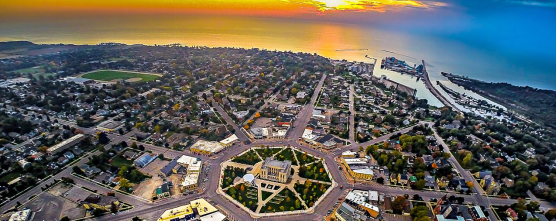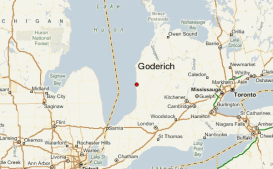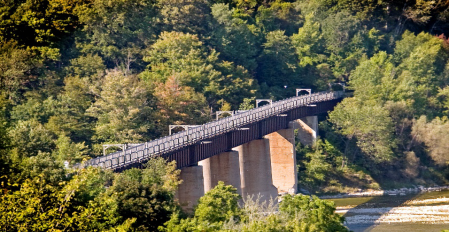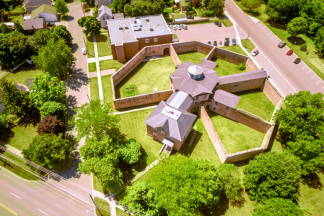Goderich, Ontario 作者: 来源: 发布时间:2021-03-29
I. Population and Area
₋ Area
Land: 8.64 km2 (3.34 sq mi)
₋ Population (2016)
Total: 7,628
Density: 882.8/km2 (2,286/sq mi)

II. Natural Geography
₋ Goderich (/ˈɡɒdrɪtʃ, ˈɡɒdərɪtʃ/ GOD-rich or GOD-ə-rich) is a town in the Canadian province of Ontario and is the county seat of Huron County. The town was founded by John Galt and William "Tiger" Dunlop of the Canada Company in 1827. First laid out in 1828, the town is named after Frederick John Robinson, 1st Viscount Goderich, who was prime minister of the United Kingdom at the time. It was incorporated as a town in 1850.

₋ As of the Canada 2016 Census, the population is 7,628 in a land area of 8.64 square kilometres.
₋ Located on the eastern shore of Lake Huron at the mouth of the Maitland River, Goderich faces the lake to the west and is notable for its sunsets. Some claim that Queen Elizabeth II once commented that Goderich was "the prettiest town in Canada" although no reigning monarch has ever visited Goderich. The town indicates that tourism is among its important industries. It has been named one of Ontario's best small towns by Comfort Life, a website for retirement living in Canada.
₋ The town participates yearly in the Communities in Bloom competition; and has won awards in many categories. In 2012, Goderich was a National Finalist in the competition, and was also part of the Circle of excellence.
₋ Tourism is also significant because many visitors spend time on the Lake Huron shore, including three beaches near Goderich, and may shop or stay overnight in town. Goderich has festivals and events each year that appeal to some visitors as well as local attractions.
₋ The Huron Historic Gaol is a National Historic Site of Canada. It served as the region's gaol (old English form of jail) from its opening in 1842 until 1972. It is open to the public between April and October. This is the site of the last public hanging in Canada. James Donnelly Sr. of the Black Donnellys also spent time here before his trial. As well, Steven Truscott was held here for some time.
₋ The Huron County Museum is a community museum which offers modern exhibition galleries. Permanent exhibits depict the early settlement and development of Huron County, including a full-size locomotive, A World War II Sherman tank, an extensive military collection, and an exhibit related to salt mining in the area. The museum also collects and maintains the Huron County Archives.
₋ Goderich features 3 public use beaches which can be reached by car following signage in town to the beach hill, also known as West Street. After parking, beach users can also walk along a wooden boardwalk over a mile in length. The main beach, at the north end of the walkway is a sand and fine gravel beach where swimmers and sunbathers can watch lake freighters loading up with salt on the other side of the pier. Further south is St. Christopher's beach and at the far end of the boardwalk is "Rotary Cove", a family-friendly sand beach with lifeguards and playground equipment. Of interest as well, are the man-made groynes along the beach, put in place to control sand migration from the action of water currents.
₋ Aside from annual festivals and events, Goderich hosts occasional special events, such as during Goderich's 150 year celebration - Jubilee 3 - there was a Skydiving Jamboree at the Goderich Airport. This event attracted hundreds of parachutists from all over the U.S.A. and Canada.
₋ Users of the TripAdvisor web site recommend the following: Menesetung Bridge walking trail, Huron Historic Gaol, the nearby Point Farms Provincial Park and Cove Beach, Goderich Lighthouse, Falls Reserve Conservation Area and the Marine Museum. Their recommended restaurants include Thyme On 21 Casual Dining, Culbert's Bakery, West Street Willy's Eatery, Pat and Kevin's on the Square and Benmiller Inn.
II. ECONOMY
₋ Goderich is in Huron County which is primarily agricultural. In fact, the Official Plan indicates that "Huron leads all counties and regions in Ontario in total value of production; and it also exceeds the production totals of several provinces. However, the town does have some manufacturing with companies such as Compass Minerals and Vestas.
₋ The salt mining industry in Goderich is one of the oldest in Ontario. In 1866, petroleum exploration crews found a massive ancient salt deposit about 300 metres (980 feet) under the surface.
₋ To date, 150 million tons of salt has been produced from the mine and by 2012, after recent investments, it will be able to produce 9 million tons a year This all started in 1866 when prospector Sam Platt was searching for oil and instead discovered rock salt 300 metres beneath Goderich Harbour. Just over 50 years ago harvesting of the salt began, and continues today by Sifto Canada. The mine is 530 metres (1,750 feet) below surface, extending 7 km2 (2.7 sq mi) under Lake Huron - roughly the size of the town. It is the largest underground salt mine in the world.
₋ The salt deposits at Goderich are from an ancient sea bed of Silurian age, part of the Salina Formation. The halite rock salt is also found in Windsor, Ontario, both located on the eastern periphery of the Michigan Basin, on the southeastern shores of Lake Huron.
₋ The Town currently lists Canadian Salt Co./ Windsor Salt Warehouse and the Compass Minerals Evaporator and its Goderich Mine as businesses involved in this industry.
₋ Volvo once operated a road grader manufacturing plant in Goderich. The plant, originally operated by locally-owned Champion Road Machinery, was one of the world's oldest manufacturers of road equipment. It was acquired by Volvo in 1997. In September 2008, Volvo announced plans to close all operations in Goderich and move operations to Shippensburg, Pennsylvania. Production in Goderich ceased in 2009.
III. Industrial Characteristics
₋ The most significant priority identified for the strategy was effective implementation. Additional findings included:
A Coordinator for Economic Development – A need for an individual or organization to lead the Town‘s Economic Development Services, which would help to attract and retain businesses as well as liaise between local, provincial and federal governments.
Downtown Revitalization – The revitalization of the Town‘s downtown, specifically retaining the unique heritage design of the area is of top priority.
Municipal Issues – While the Town has limited access to available serviced land, municipal zoning and tax concerns were identified as important issues that need to be addressed by the Town.
New Business – The community must be proactive and responsive to business investment opportunities and take a more positive role in the future expansion of existing businesses.
Training and Development – An important contribution to the success of the Town‘s local businesses is access to a strong local labour force. By providing training and education to its residents, the business community of Goderich can gain greater access to a well trained labour force within the local area.
Tourism – In order to continue the development of the tourism industry in Goderich, the promotion of partnership development and joint marketing among local stakeholders will be key to the growth of this sector.
Transportation – Access to local public transportation is an issue for those unable to drive, a full review of available usage in the area, along with the investigation of costs for a local bus service is required to improve the current public transportation system.
IV. Attractions
1. Menesetung Bridge

₋ The Menesetung Bridge spans the Maitland River near its entry into Lake Huron, connecting the Town of Goderich and the Township of Ashfield-Colborne-Wawanosh. The seven-span steel and wood railway bridge was constructed between 1906 and 1907.
₋ The property was designated by the Town of Goderich in 1993 for its architectural and historical significance under Part IV of the Ontario Heritage Act (By-law 90 of 1993).
₋ HERITAGE VALUE
₋ Located within the harbour area of the Town of Goderich, the Menesetung Bridge is a visual reminder of the important role of Lake Huron and the railway to the development of Goderich. The harbour and the train station, located to the south of the bridge, were the industrial and commercial hub of early Goderich and greatly contributed to the success of the town.
₋ The Menesetung Bridge was vital to the development of Goderich as a thriving port town. The train service which crossed the Maitland River via the Menesetung Bridge on the Canadian Pacific Railway (CPR) Guelph-Goderich Line brought business and passengers to the harbour town and, through their commerce and trade, Goderich flourished. The construction, which began in 1906 by M.A. Pigott of Hamilton, was often delayed due to disputes with the competing Grand Trunk Railway (GTR).
₋ The Menesetung Bridge's official opening ceremonies took place on September 19, 1907 and the bridge served the Town of Goderich and the CPR for over 80 years. In 1988, the final CPR train stopped on the bridge and blew its whistle for a final time. Today, due in large part to the efforts of the local community to save the bridge when it was threatened in the early 1990s, the Menesetung Bridge serves as a pedestrian bridge as part of the Maitland Trail.
₋ The Menesetung Bridge was the longest bridge in Ontario at the time of its construction and is a fine example of a typical Canadian Pacific Rail bridge. The seven spans each measure 104 feet in length and 12 feet in width, creating a total length of 750 feet. The bridge is held up by 2 abutments and 6 concrete piers which rise about 60 metres from the Maitland River. The embankments were reinforced with millions of tons of earth, which also reduced the grade from the Township of Colborne into the Goderich Harbour.
₋ Website: https://www.historicplaces.ca/en/rep-reg/place-lieu.aspx?id=14596
2. Huron Historic Gaol

₋ The Huron Historic Gaol was established as the Huron County Gaol for Upper Canada's Huron District. Clearing of the land began in Goderich, Ontario in 1839 and the jail was constructed between 1839 and 1842 using stone from the Maitland River Valley and from Michigan. The octagonal jail was designed by Thomas Young, modelled after Jeremy Bentham’s Panopticon design for prison construction, common in mid-19th century Britain and North America.
₋ A temporary courtroom and Council Chambers were set up on the jail’s third floor. It was in this makeshift Council Chamber that the first Huron District Council meeting was held on February 8, 1842. The third floor was also used for church services and other public gatherings before proper buildings were available. The building served the dual purpose of jail and courthouse until the construction of the county courthouse was completed in 1856, in the centre of Goderich’s Market Square.
₋ The site ceased functioning as a jail serving Huron County in 1972 and inmates were then transferred to Walkerton and Stratford jails. It was designated a National Historic Site of Canada in 1973.
₋ Three inmates were hung at the jail, with two of the hangings conducted publicly. On December 18, 1861 William Mahone was hung outside the jail walls. An exterior wall of the jail was the location of the last public execution that occurred in Canada, when on December 7, 1869, Nicholas Melady was hanged for the murder of his father and stepmother. Edward Jardine was hanged privately on June 16, 1911.
₋ Steven Truscott awaited execution in the Huron County Gaol from September 30, 1959, when he was convicted at age 14 of the murder of Lynne Harper, until his sentence was commuted to life imprisonment on January 22, 1960. On August 28, 2007, Truscott was acquitted of the charges.
₋ Website: https://www.huroncountymuseum.ca/huron-historic-gaol/
₋ Phone: (519) 524-6971
3. Goderich Main Beach

₋ Goderich's three beautiful beaches are a must-see. With free parking, picnic shelters, playgrounds, and public washrooms these beaches are the perfect location for a day trip. With a boardwalk stretching 1.5 kilometres along the beachfront, you can be sure to catch our famous sunsets from every angle. The hours of operation are 6 a.m. - 11 p.m. Recreational vehicles and trailers of any type are prohibited. Check our list of campgrounds to find a convenient place to camp.
₋ Website: https://www.goderich.ca/en/stay-and-play/beaches.aspx
V. History
₋ According to the historic plaques erected by the Province, the Canada Company acquired the vast amount of land called the Huron Tract in 1826 and in 1827, under Superintendent John Galt, established its base in what would become Goderich. Development was under way by 1829. In 1850, with a population of about 1,000, the community was incorporated as a town. In addition to Galt, another important individual was Dr. William "Tiger" Dunlop who was Warden of the Forests for the Canada Company, and helped develop the Huron Tract and later, to found Goderich. Also noteworthy, Thomas Mercer Jones administered much of the million acre Tract and built a richly furnished mansion, Park House, in Goderich in about 1839.
₋ Town records indicate that the Huron Tract had been acquired by the government from the Chippewa First Nation and that the location of the community was based on coastal surveys completed in 1824 by Captain Bayfield. A log cabin was erected, at the top of the hill overlooking the harbor in 1827; this building, the home of Dr. William "Tiger" Dunlop, was later referred to as "The Castle".
₋ An 1846 Gazette indicated that a harbour was operating but the docks were not in a good state of repair. A light house was being erected. Roads were available to Wilmot Township, Ontario and to the town of London, Ontario. Shipbuilding was already underway. A fishing company had started but did not succeed and closed down. There were five churches in Goderich, four Protestant and one Roman Catholic. By 1869 the population was 4,500; a railway station and steamship docks were in operation. Wheat was the primary crop shipped from this area.
₋ Research by the University of Waterloo indicates that the Canada Company built piers to protect ships in the harbor between 1830 and 1850 and in 1872 the first modern harbor was created. The railway arrived in June 1858 and a grain elevator was erected in 1859. Harbour Hill was graded in 1850. Fishing became an important part of the community and the pier was lined with fish shanties. A modern rail station was built near the harbor and the building still stands today. Goderich became a very busy rail shipping location by the 1940s and had a roadhouse and turntable until the 1960s. Salt mining, which eventually became a major industry, was started in 1866 when Samuel Platt began opening salt mines beside his flour mill on the Maitland River. The harbour at Goderich was also the home of large flour mills starting in the 1870s.
₋ The Smith's Canadian Gazetteer of 1846 describes Goderich as follows:
It was laid out in 1827 by Mr. Galt ... the town is rather exposed to north and north west winds from the lake, in consequence of which the weather is occasionally wintry, even in the middle of summer ... Owing to Its remote situation ... Goderich has not increased as fast as many other places of the same age. A harbour has been constructed but the piers are now getting out of repair. This is the only harbour between Port Sarnia and the Saugeen Islands. A light house is just about being erected .... A steamboat and several schooners have been built here. Stages run twice a week from Goderich to London and Galt, and during the last season the steamboat Goderich called here on her weekly trips ... A fishing company was established here, some years since, but from some mismanagement did not succeed very-well, and is now broken up. Goderich contains five churches and chapels, ... there is also a stone jail and court house, and the Canada Company's offices... Post Office, post four times a week. Population, 659."
₋ The Goderich lighthouse, the first on the Canadian side of Lake Huron, opened in 1847 with a tower and the keeper's house. After the 1913 storm it was remodeled. A severe storm on Lake Huron in November 1913 caused the loss of 19 ships and 244 lives. A great deal of wreckage floated to the Goderich area shore, The bodies of the sailors were identified and collected by a Lake Carriers' Association committee based at Goderich.
₋ In 1866, four artesian wells began providing the town's water and also attracted tourists who had heard about the water's medicinal properties. The Ocean House Hotel, built in the 1850s, housed many tourists. From about 1910, the sandy beach near town were also used heavily by locals and by visitors who appreciated the shallow, warm water. In 1930, a "bathing house" was built with lockers, restrooms and a small store.
₋ Early in World War II, what is now the Goderich Airport became the site of one of Canada's air training facilities; it opened in December 1939, at Sky Harbour. The school operated until March 1945. A Lancaster X airplane, FM 213, was donated in the 1960s by Branch 109 Royal Canadian Legion in honour of those who died or went missing during the war.
₋ Goderich has many historically designated buildings, listed on a map published by the Town.
₋ In 2018 a strike involving over 350 salt mine workers broke out in Goderich, following labor disputes between the Unifor Local 16-0 union and the American owned company Compass Minerals, which owns the mine, over a new contract. The strike ended in July of 2018 having lasted for 12 weeks.
₋ The Square
₋ Goderich's downtown has an octagonal traffic circle known as 'The Square'. The county courthouse stands in the middle of The Square. This is where, in 1959, Steven Truscott was convicted of murdering Lynne Harper. The conviction was overturned in 2007.
₋ The Square was formally listed in the Register of Historic Place by the Government of Canada in May 2007. The Town had already recognized the value of the area in 1982, under the Ontario Heritage Act.
₋ The Square was designed and developed between 1840 and the mid 1890s and in its early days, contained the main office of the Canada Company which helped to develop much of the county. The design of the square - a "radial composition" - is attributed to John Galt of the Company, inspired by ancient Roman city plans. Over the years it was called "Market Square", "The Square" or "Courthouse Square" by locals. The original courthouse was located here but was destroyed in a fire and replaced by a modern structure in the 1950s.
₋ Contrary to a popularly held belief, plans for The Square were not intended for Guelph. It is thought this rumour started when Goderich was founded, as town planners the Canada Company originally wanted their community to be called Guelph after the Royal Family; the Company eventually resigned to accepting the decisions of Superintendent John Galt to keep the name Goderich.
₋ On the afternoon of 21 August 2011, an F3 tornado touched down in the town, after coming ashore as a waterspout as the mesocyclone thunderstorm cell moved across Lake Huron. It was the strongest tornado that had hit Ontario since the Arthur, Ontario tornado of April 20, 1996, though on average, F3 tornadoes occur in Ontario every eight years. The devastating storm downed power lines, tore roofs from houses, and left cars and trees scattered along city streets. Hundred-year-old trees surrounding the Goderich Courthouse were uprooted in seconds. The tornado killed one person: Norman Laberge, 61, of Lucknow, who was working on a dock associated with a salt mine on the coast of Lake Huron when the storm hit. 37 people were injured. The Environment Canada weather forecast office in Toronto issued a tornado warning for Goderich and southern Huron County 12 minutes before the tornado struck. The town did not have a tornado siren unlike some other Ontario cities.
₋ News reports later indicated that one hundred houses, 25 buildings and thousands of 150-plus-year-old trees were seriously damaged or destroyed.
₋ Rebuilding The Square area
₋ After the tornado, a news report described The Square area as follows: "The roofs of several buildings ringing the square were torn off. The green space around the courthouse at the centre of the square was littered with tree limbs and trees that had been ripped out of the ground."
₋ A year later, 152 of the 170 downtown businesses had reopened but reconstruction of the courthouse, some historic buildings and the trees in the area took much longer.
₋ A visitor to the area nearly four years after the event found that the park had re-opened with a new band shell. New trees, greenery, a statue and a water feature had been installed in front of the court house. Much of the area around the park had been reconstructed including commercial building on Kingston Street and The Square. The last work to be completed was the Kingston block of commercial buildings on Kingston Street and The Square. Although the farmers' market and flea market had closed before the tornado, it re-opened.
VI. Other Information
₋ Ports
₋ Goderich Airport (known unofficially as Sky Harbour Airport) is a community airport with three runways: two are paved, with runway lighting, and one is grass. It is located directly north of the town, and is accessible via the Bluewater Highway north of the community. During WWII, The airport was the site of an Elementary Flying Training School as part of the British Commonwealth Air Training Plan. In addition to flight services, several industries are located in the immediate area of the airport to provide the full range of services that aviation requires, including interior and exterior re-finishing, and mechanical repairs.
₋ Goderich Harbour is owned by the town, but is operated under contract by Goderich Port Management Corporation. It is an industrial harbour, used primarily to load salt from the Sifto salt mines onto lake and ocean freighters.
₋ Snug Harbour is a marina located within the industrial harbour basin; Maitland Valley Marina is also located near Goderich.
₋ Railways
₋ The Goderich-Exeter Railway currently operates freight service to Goderich. The line was built by the Buffalo and Lake Huron Railway in 1859. The railway was soon taken over by the Grand Trunk Railway, later CN. In 1992, the line was sold to the GEXR.
₋ CPR built a second railway into Goderich in 1907. Passenger service ran until the 1960s. The entire line was abandoned in 1989. The trestle crossing over the Maitland River was converted through public fund-raising into a public walkway, offering views of the harbour, Maitland Valley golf course and the river valley itself. The Ontario West Shore Railway started to build a railway from Goderich to Kincardine in 1909, but it was never completely opened.
VII. Contact Information
₋ Government
Mayor: John Grace
₋ Town of Goderich
Office Hours: Monday to Friday 8:00 am to 4:00 pm
Effective March 17, 2020 until further notice, our doors will be closed to the public. Staff may be reached by phone, fax or email.
Address: 57 West Street, Goderich, Ontario N7A 2K5
F. 519-524-7209
